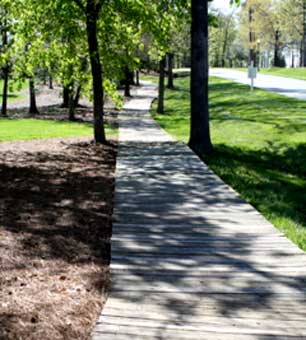The history of Uwharrie Point dates back to 1917 when the Aluminum Company of America (ALCOA) dammed the Yadkin River and created Badin Lake. Prior to that, the area was primal forestry and peaceful farmland.
Before ALCOA, there had been two other attempts to dam the river. The first was made in the 1890’s by Pittsburgh financier and capitalist George Whitney. He bought the Yadkin River Valley with the intention of mining it for its gold, copper and granite deposits.
To provide hydroelectric power for his mining operations, Whitney acquired a large tract of land west of the peninsula on which he proposed to build a dam. In 1901 he began construction using granite blocks from the Whitney Quarry, about 20 miles away. The granite was transported on a railroad Whitney had built the previous year. (These tracks are still used today by the Winston-Salem Southbound Railroad.) By 1907, having lost $19 million and bankrupt, Whitney headed back north, leaving the dam unfinished. Today, when the Yadkin is extremely low, remnants of Whitney’s granite dam can be seen.
In 1912, a French company called L’Aluminium François bought Whitney’s property. When they discovered a better place on the river to harness power, they abandoned Whitney’s dam and began building at the Narrows, an area south of Uwharrie Point.
With the outbreak of World War I in 1914, the French reservists’ workers went home, and the company rapidly lost it′s credit. The next year, L’Aluminium François sold its holdings to Andrew Mellon’s conglomerate, ALCOA.
Immediately, ALCOA took over hydroelectric power development on the Yadkin and launched efforts to complete the dam begun by the French. After finishing the Narrows Dam, ALCOA quickly followed with construction of Falls Dam in 1919, located south of the Narrows Dam, and High Rock dam in 1927, located 15 miles north of Narrows Dam. The final dam, located at Tuckertown, was completed in 1963. These four dams have controlled the strength of the Yadkin River and created several vast, peaceful lakes.
In 1920, typhoid fever drove the last inhabitants off the Uwharrie Point peninsula, leaving behind small farms. In 1935, Pearl Pleasant Futrell, a lumber mill owner from nearby Eldorado, bought the peninsula from two Montgomery County residents named Harris and Rankin. When Futrell died in 1986, the property passed to his sons, Dale and Gilbert. In 1990, they sold the peninsula to Lake Badin Associates to be developed as a second home lake and golf course community.
In an area with such a rich natural past, it is not surprising that Uwharrie Point shares with its surroundings a long history of Indian and folk lore. Indian relics left by the Uwharrie Indians, who made this their home over 500 years ago, can still be found. And the ghost of the Uwharrie Mountain, Bluebeard, who killed all seven of his wives with a knitting needle, is said to be still prowling about looking for his missing needle.
In developing Uwharrie Point, care was taken to retain its ancient history. A chimney from an old home place stands on the 5th tee box of the golf course. Another one stands silently in the woods near the road that leads to the Lodge, and a third one rests to the left of the guardhouse. There is also a Civil War grave site off Uwharrie Point Parkway, southwest of the entrance to Old North State Lane.
In designing Uwharrie Point, developers were sensitive not only to the land, but also to its unique place in history. To reflect this, the community and parkway were named for the Uwharrie National Forest, and the streets were named for other sites around North Carolina. Lodge rooms at The Old North State Club reflect the names of surrounding counties, and the Old North State Club wears the historic moniker of the state. While there are many interesting landmarks and scenes throughout the community, the 18th hole of the golf course is one of the most awe inspiring. It was carefully positioned along the west side of the peninsula to take advantage of the panoramic lake view and majestic sunsets.
Some things have changed over the years, but life on the peninsula is much the same as it was many years ago. Sunrises and sunsets over the lake are still breathtaking, deer roam freely, days are just as relaxing, and the land remains a wealth of natural beauty.

Insider Information |
About Us  |
History  |
News/Updates  |
FAQ  |
Newsletters  |
Join Our Mailing List
Stay abreast of what's available at Old North State. We promise not to sell your information.
Join Now